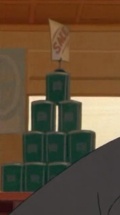 According to the Bible, drugs factor significantly in how the great city Babylon deceives.
According to the Bible, drugs factor significantly in how the great city Babylon deceives. and the light of a lamp will not shine in you (the great city Babylon) any longer; and the voice of the bridegroom and bride will not be heard in you any longer; for your merchants were the great men of the earth, because all the nations (ethnos) were deceived by your sorcery (pharmakeia).
Revelation 18:23
The working of this sorcery, or, enchantment that is pharmakeia is modeled for us in two notable scenes. In one, the nine year old boy, Hogarth, drugs his opponent in a successful bid to elude him so he can carry out his activity in secret. In the other, he subjects himself to the influence of a drug, and while under the influence hears a philosophical suggestion he accepts as truth. That philosophy, which is true on one level, is later stretched into a lie that becomes the key to the salvation of the lives of men at the climax of the movie. That same lie will induce some to accept the mark of the Beast, presuming that one can repent of it when, in truth, one cannot!
If you're new to the series, what you'll read here might seem far-fetched, so, do yourself a favor and start at the beginning. You may even want to begin at the end of October 2009 and work your way forward. If you've been following the series but haven't yet read the recently updated version of Pharmaceuticals - The Sorceries of Babylon, you may find your foundation for this vital subject lacking. That study was updated and expanded as a supporting adjunct to this series and for this post in particular.
The scene where Hogarth drugs his opponent takes place in a
 Rexall Pharmacy, a classic 50s drugstore with a soda fountain. Hogarth is there, accompanied by Kent Mansley, a government agent who has attached himself to Hogarth in an effort to discover the whereabouts of the iron giant. Hogarth is hiding the iron giant and wants to lose Kent so he can go visit the giant at the secret hideout.
Rexall Pharmacy, a classic 50s drugstore with a soda fountain. Hogarth is there, accompanied by Kent Mansley, a government agent who has attached himself to Hogarth in an effort to discover the whereabouts of the iron giant. Hogarth is hiding the iron giant and wants to lose Kent so he can go visit the giant at the secret hideout. In a bid to shake Kent,
 Hogarth acquires the drug of choice and administers it to the agent on the sly. The drug is coco-lax, a laxative, and the plan is to get away when the effects of the laxative force the agent to use the restroom. The ploy is successful and Hogarth evades the agent to carry out his plan in secret.
Hogarth acquires the drug of choice and administers it to the agent on the sly. The drug is coco-lax, a laxative, and the plan is to get away when the effects of the laxative force the agent to use the restroom. The ploy is successful and Hogarth evades the agent to carry out his plan in secret.Ethically, of course, this is not the kind of example you want your children to model; practicing deceit, using drugs to manipulate people. In the movie, Hogarth lies frequently, threatens and bullies to get his way, is nearly always disobedient to his mother and disrespects all those in authority. Yet, he is the protagonist and Kent, the antagonist, and so this ploy is justified.
 But, no, not really. This kind of presentation is how you train up people in lawlessness.
But, no, not really. This kind of presentation is how you train up people in lawlessness.If you have read the adjunct study about pharmaceuticals you probably understand the reason why the Rx symbol is featured in the drugstore imagery. It is a silent inducement, rendered 'recipere' or 'recipe' in Latin and meaning, "take thou."
 This is fulfilled by the lawless Hogarth as he employs pharmakeia to exert his will.
This is fulfilled by the lawless Hogarth as he employs pharmakeia to exert his will. The Rx symbol
 also signifies the Beast and the mark of the beast as the eye of Horus. During the scene in the pharmacy, the "camera" pans past a pyramid that reveals what's really being sold here. Attached to the capstone is a sale sign. We're being sold the Beast, a message I've pointed out over and again, signaled in this antichrist promotional vehicle in a wide variety of ways!
also signifies the Beast and the mark of the beast as the eye of Horus. During the scene in the pharmacy, the "camera" pans past a pyramid that reveals what's really being sold here. Attached to the capstone is a sale sign. We're being sold the Beast, a message I've pointed out over and again, signaled in this antichrist promotional vehicle in a wide variety of ways! In the first pharmakeia scene there is nothing particularly subtle about the drug ploy. In the next, it's very subtle because, while the drug use is obvious, its role in the implantation of the lie is not.
To be continued - Lord willing!

No comments:
Post a Comment